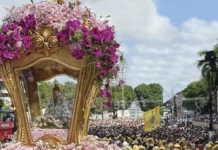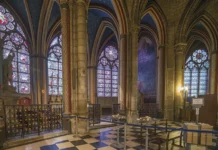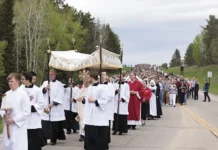Statue of the Blessed Virgin left intact in tornado’s wake
While the world has been struck by numerous natural disasters in recent months, the Blessed Virgin seems to have wanted to manifest her protective action in many of them, symbolized by images that remain intact after the occurrence of some cataclysm.
This is what recently occurred with a statue of Our Lady with the Child Jesus in her arms, located in front of Resurrection Parish in the city of Dawson Springs, Kentucky. The church was destroyed by a tornado that tore through the region, but the statue remained standing, suffering only minor damage.
Between December 10 and 11, 2021, seventy tornadoes struck ten US States, Kentucky suffering the highest tolls. In that state alone, there were seventy-five deaths, 126 persons injured, and widespread destruction involving thousands of buildings.
Over a thousand anti-religious acts in France in 2021
According to France’s Minister of the Interior, Gérald Darmanin, from January to October 2021 approximately one thousand four hundred anti-religious acts were registered in this country, ranging from insults to vandalism. Although this represents a decline as compared with 2019, the numbers are still high, especially in relation to Christianity, which was the object of 686 of the attacks.
And the violence continues. On December 8, the Solemnity of the Immaculate Conception, some of the faithful who were taking part in a procession between two churches in the city of Nanterre were verbally assaulted and threatened by a group of people. The Minister of the Interior has recommended that the diocese denounce this, stating that death threats are completely unacceptable.
Synagogue from the time of Christ discovered in Magdala
In 2009 the ruins of a synagogue dating from the time of Jesus were found in the lands of St. Mary Magdalene. In December 2021, the Israel Antiquities Authority announced the discovery of another synagogue only one hundred and sixty metres from the previous one, dating from the same period. Both seem to have suffered the effects of war, especially on the occasion of the destruction of Jerusalem by the Romans in 70 AD.
The city of Magdala was located at the foot of Mount Arbel, on the shores of the Sea of Galilee, the natural path from Nazareth to Capernaum, which, based on biblical accounts, supports the belief that Jesus visited these synagogues with His disciples.

Biography of Benedict XVI Now Published in Portuguese
At the beginning of December, the Joseph Ratzinger-Benedict XVI Vatican Foundation in Rome presented the biography of the Pope Emeritus written by Peter Seewald, in Italian: Benedetto XVI. Una vita.
A few days later, on December 12, Benedict XVI received from the hands of Monsignor Antonio Luiz Catelan Ferreira, recently appointed Auxiliary Bishop of Rio de Janeiro, member of the International Theological Commission and secretary of the Ratzinger Society of Brazil, an edition of the biography in Portuguese. The work was originally published in Germany in 2020.
Roman-era ring with effigy of the Good Shepherd found
The figure of the Good Shepherd, one of the most ancient artistic representations of Our Lord Jesus Christ, is often associated with the Roman catacombs of the early Christian era. But now it has turned up in a treasure trove found by divers from the Israel Antiquities Authority off Israel’s Mediterranean coast. The discovery is from two shipwrecks that occurred near the ancient port of Caesarea, one of them in the third century.
Among the objects retrieved from the sea was a large Roman-era gold ring of an octagonal shape, set with a green gemstone. On the stone is carved a depiction of a young shepherd carrying a sheep on his shoulders, typical features of the aforementioned representation of the Redeemer. The Israel Antiquities Authority considers the figure to be a symbol of salvation, and a testimony to faith in Jesus Christ. The numismatic department of the institution also stated that this is an exceptional find, which reveals the growth of Christianity in the third century.
Odetinha is declared Venerable
 In November, the heroic virtues of Odette Vidal Cardoso – affectionately known as Odetinha – were recognized. She now receives the title of Venerable, thus advancing one step further in her process of canonization. Odetinha could become the first Cariocan Saint.
In November, the heroic virtues of Odette Vidal Cardoso – affectionately known as Odetinha – were recognized. She now receives the title of Venerable, thus advancing one step further in her process of canonization. Odetinha could become the first Cariocan Saint.
Born on September 15, 1930, in Rio de Janeiro, she was a lily of innocence and died at the age of nine, on November 25, 1939, of paratyphoid. From the age of four she had intimate conversations with Jesus in the Blessed Sacrament, for whom she had great devotion. She made her First Holy Communion on August 15, 1937, at the age of seven.
The process of beatification of Odetinha was initiated in January 2013 and since then the remains of the girl have been exposed for public devotion in the Basilica of the Immaculate Conception in the capital of the State of Rio de Janeiro.
Catholic catechist murdered in Mozambique
On December 15, while walking with his wife and children to an agricultural field in the Cabo Delgado region of northern Mozambique, Matias Buscam, a Catholic catechist, was approached by Muslim terrorists, who cruelly beheaded him. The murderers then forced his wife to carry his head to the authorities with this message: “We are still here.”
The Apostolic Administrator of the Diocese of Pemba, Bishop Antonio Juliasse Ferreira Sandramo, has expressed great concern over the increase in terrorist attacks in his jurisdiction, saying there is a lot of insecurity despite the presence of foreign military in the region. Since October 2017, over three thousand people have been killed in armed attacks.
Scholars try to recreate sound of the medieval bells of the Basilica of the Nativity
The melodious tones that rang out almost eight hundred years ago in the place where Our Lord Jesus Christ was born could resound again in our days. This is the hope of researchers from European universities who are studying the medieval bells of the Basilica of the Nativity, with a view to casting functional copies.
David Catalunya, a researcher at the Universities of Oxford and Würzburg and director of the project, explains that in the 13th century, just prior to the Muslim occupation of the Holy Land, the crusaders who were in the city of Bethlehem buried the thirteen bronze bells of the church to save them from destruction.
According to Fr. Stephane, liturgist of the Franciscan Custody of the Holy Land, the bells were discovered at the beginning of the 20th century, along with 222 copper pipes from the medieval organ of the church of Bethlehem, during restoration work on the edifice. The bells formed part of a carillon that accompanied the songs of the faithful during the celebrations held there.








